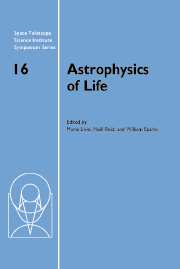 Astrophysics of Life
Astrophysics of Life Book contents
- Frontmatter
- Contents
- Participants
- Preface
- A voyage from dark clouds to the early Earth
- Galactic environment of the Sun and stars: Interstellar and interplanetary material
- Transits
- Planet migration
- Organic synthesis in space
- The vegetation red edge spectroscopic feature as a surface biomarker
- Search for extra-solar planets through gravitational lensing
- The Galactic Habitable Zone
- Cosmology and life
The vegetation red edge spectroscopic feature as a surface biomarker
Published online by Cambridge University Press: 29 August 2009
- Frontmatter
- Contents
- Participants
- Preface
- A voyage from dark clouds to the early Earth
- Galactic environment of the Sun and stars: Interstellar and interplanetary material
- Transits
- Planet migration
- Organic synthesis in space
- The vegetation red edge spectroscopic feature as a surface biomarker
- Search for extra-solar planets through gravitational lensing
- The Galactic Habitable Zone
- Cosmology and life
Summary
The search for Earth-like extrasolar planets is in part motivated by the potential detection of spectroscopic biomarkers. Spectroscopic biomarkers are spectral features that are either consistent with life, indicative of habitability, or provide clues to a planet's habitability. Most attention so far has been given to atmospheric biomarkers, gases such as O2, O3, H2O, CO, and CH4. Here we discuss surface biomarkers. Surface biomarkers that have large, distinct, abrupt changes in their spectra may be detectable in an extrasolar planet's spectrum at wavelengths that penetrate to the planetary surface. Earth has such a surface biomarker: the vegetation “red edge” spectroscopic feature. Recent interest in Earth's surface biomarker has motivated Earthshine observations of the spatially unresolved Earth and two recent studies may have detected the vegetation red edge feature in Earth's hemispherically integrated spectrum. A photometric time series in different colors should help in detecting unusual surface features in extrasolar Earth-like planet spectra.
Introduction
One hundred extrasolar giant planets are currently known to orbit nearby sun-like stars. These planets have been detected by the radial velocity method and so, with the exception of the one transiting planet, only the minimum mass and orbital parameters are known. Many plans are underway to learn more about extrasolar planets' physical properties from ground-based and space-based observations and via proposed or planned space missions. Direct detection of scattered or thermally emitted light from the planet itself is the only way to learn about a variety of the planet's physical characteristics.
- Type
- Chapter
- Information
- Astrophysics of LifeProceedings of the Space Telescope Science Institute Symposium, held in Baltimore, Maryland May 6–9, 2002, pp. 67 - 75Publisher: Cambridge University PressPrint publication year: 2005
- 1
- Cited by
